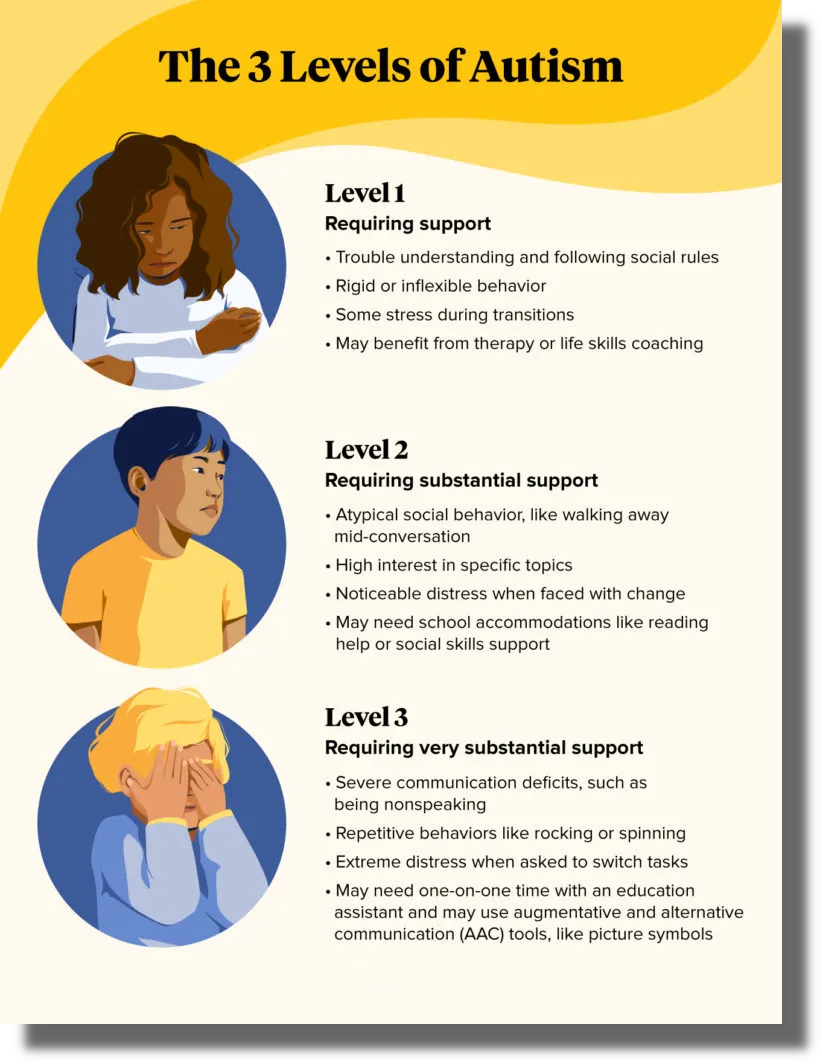Best practices for building sensory-friendly spaces with advice from an Autism Therapist
Best practices for building sensory-friendly spaces with advice from an Autism Therapist
Blog Article
Exploring Efficient Methods for Supporting Individuals With Behavioral Autism
Sustaining individuals with behavioral autism needs a nuanced understanding of their one-of-a-kind demands. You'll locate that customized treatments, based in evidence-based methods, can make a significant difference. By teaming up with specialists and families, you can produce a tailored approach that fosters communication and development. But what specific methods can you execute to guarantee these people thrive? Allow's discover the effective approaches that can improve their day-to-day experiences.
Recognizing Behavior Autism: Trick Characteristics and Challenges
When you begin to recognize behavior autism, you'll discover a number of crucial attributes and challenges that specify the experience for individuals. Many individuals with behavioral autism usually deal with communication, making it tough for them to express their emotions or needs properly. You might observe repetitive behaviors, such as hand-flapping or rocking, which serve as coping devices for managing anxiety or sensory overload. Social communications may be testing; individuals may locate it difficult to read social signs, causing misunderstandings in connections.
Furthermore, sensory level of sensitivities are common, causing discomfort in atmospheres with loud noises or brilliant lights. These obstacles can result in stress and anxiety or disappointment, affecting every day life. It is necessary to acknowledge that each individual is special, and their experiences may differ. Comprehending these qualities permits you to approach support with compassion, fostering a positive connection that can improve their wellness and motivate development.
The Significance of Personalized Interventions
When it comes to supporting individuals with behavioral autism, customized treatments are essential. By creating customized intervention plans that focus on individual strengths, you can considerably enhance their growth. Collaborating with assistance groups guarantees every person is lined up in offering the very best treatment possible.
Tailored Intervention Strategies
Producing tailored treatment plans is vital for effectively supporting individuals with behavior autism, as everyone's needs, challenges, and strengths differ substantially. By crafting these customized plans, you can address particular behaviors and goals, guaranteeing an extra focused strategy. Beginning by collecting comprehensive info about the individual, including their preferences, activates, and past experiences. Team up with caretakers, therapists, and educators to determine approaches that resonate with them. Continually keep an eye on development and readjust the strategy as necessary, guaranteeing it continues to be relevant and efficient. This versatility not only promotes interaction however additionally advertises a sense of possession and empowerment for the individual. Eventually, customized intervention plans can significantly enhance the quality of assistance you supply, resulting in even more meaningful results.
Individual Staminas Analysis
A private staminas analysis is necessary for developing personalized treatments for people with behavioral autism. By concentrating on everyone's unique abilities, you can create methods that reverberate with their passions and abilities. This method not just improves interaction however likewise enhances confidence.
When you identify toughness, like phenomenal memory or imaginative ability, you can tailor interventions that utilize these locations. This not only makes finding out more efficient yet additionally cultivates a sense of achievement. Bear in mind, every person has unique capabilities; acknowledging them empowers you to craft purposeful experiences.
Integrating these strengths into restorative techniques and everyday regimens can result in enhanced end results. Inevitably, prioritizing strengths warranties that treatments are not simply efficient but likewise enriching for the individual.
Collaborative Assistance Groups
Identifying specific staminas sets the stage for creating joint support groups that concentrate on tailored interventions. By bringing with each other experts, family participants, and the people themselves, you develop a supportive network that tailors methods to meet particular requirements. Each employee adds special insights, making sure a detailed strategy that deals with behavioral obstacles successfully.
This adaptability is important, as it aids everyone engaged stay lined up with the person's preferences and goals. Furthermore, involving in this team-based method encourages individuals with autism, advertising their self-advocacy and self-confidence.
Evidence-Based Communication Techniques

When collaborating with individuals on the autism spectrum, using evidence-based interaction methods can significantly improve their ability to link and share themselves. Making use of aesthetic supports, like image schedules or communication boards, assists clear up assumptions and promotes self-reliance. Simplifying language and making use of concrete terms enables better understanding, reducing frustration.
Including social stories can prepare individuals for numerous circumstances, instructing them ideal feedbacks and habits. Urging the usage of assistive innovation, such as speech-generating tools, encourages people to interact better. In addition, using consistent routines and foreseeable atmospheres can give a sense of safety and security, making interaction extra reliable.
Keep in mind to be patient and provide time to refine your words. Engaging in energetic listening, where you mirror their ideas and feelings, can enhance your connection. By applying these strategies, you'll create a more helpful interaction atmosphere for people with autism.
Producing Helpful Atmospheres
Creating encouraging settings for individuals with behavioral autism starts with carrying out organized regimens that give predictability and safety and security. You'll also wish to make sensory-friendly spaces that cater to individual demands, decreasing frustrating stimuli. Furthermore, utilizing favorable support strategies can encourage desired habits and cultivate a feeling of achievement.
Structured Regular Application
Developing a structured routine can considerably boost the setting for people with behavior autism. By creating a consistent timetable, you offer predictability, which can decrease stress and anxiety and complication. A well-structured environment cultivates independence and self-confidence, supporting their total growth.
Sensory-Friendly Spaces Style

Positive Reinforcement Techniques
When you incorporate favorable support strategies right into your strategy, you can considerably improve the discovering and behavior end results for individuals with autism. Begin by determining what encourages the private-- be it praise, tokens, or special tasks. You can likewise progressively enhance the intricacy of tasks as individuals come to be extra comfortable, enhancing their progression.
Collective Approaches: Collaborating With Experts and families

Entailing relative in decision-making equips them and enhances their capacity to sustain their liked ones. Experts, consisting of instructors and specialists, can give important resources and training that even more aid households.
You must additionally appreciate each celebration's point of view, identifying that households recognize their child best while experts bring specialized expertise. By crafting personalized strategies with each other, you develop a customized method that resolves distinct needs. Autism Spectrum Therapies. Eventually, this collaboration not only profits the specific with autism however additionally enhances the assistance network surrounding them, making it extra natural and efficient
Integrating Social Abilities Educating
Structure on the solid collaborations formed between specialists and families, integrating social skills training can considerably improve the support provided to people with behavior autism. This training assists you instruct crucial communication skills, such as starting conversations, recognizing non-verbal hints, and reacting appropriately in social situations.
By utilizing organized tasks, role-playing, and real-life circumstances, you create opportunities for technique in a safe setting. Encourage individuals to join team setups where they can involve with peers, promoting relationships and boosting their comfort in social contexts.
It's crucial to customize the training to every person's distinct toughness and difficulties, ensuring they really feel positive and capable. Regularly including feedback from both experts and family members can fine-tune these methods, making social skills training much more reliable. Inevitably, you're empowering people with the devices they need to navigate social communications effectively and build significant connections.
Keeping An Eye On Progress and Adjusting Strategies
As you implement social abilities training, it's important to check development and readjust strategies accordingly. Keep track of habits, keeping in mind enhancements and obstacles.
Involve the individual in representation, asking exactly how they feel concerning their development and what obstacles they face. This responses is vital for tailoring your technique. Don't wait to modify them. if specific strategies aren't producing results.
Work together with various other caregivers or experts for fresh point of views and insights. By remaining receptive and conscientious, you create a setting that promotes growth and growth.
Frequently Asked Inquiries
What Are the Typical Misconceptions Regarding Behavioral Autism?
You could assume behavioral autism just influences interaction, however it encompasses a lot extra. Many believe all people with autism act the same, neglecting their unique characteristics and abilities. It's important to understand everyone's differences.
How Can Innovation Help in Supporting Individuals With Behavioral Autism?
Technology can boost interaction, supplying tools like apps for social abilities and habits monitoring. You can make use of digital reality for immersive experiences, and wearable tools can keep an eye on emotions, aiding you sustain individuals efficiently.
What Duty Do Sensory Processing Issues Play in Behavioral Autism?
Sensory handling concerns can considerably influence behavior. You could notice that overwhelming sensory input leads to anxiety or crises. Understanding these challenges helps you produce an extra supportive environment for people experiencing sensory overload.
Exist Details Nutritional Suggestions for People With Behavior Autism?
Yes, details nutritional referrals can assist. You may consider a gluten-free or casein-free diet regimen, which some find helpful (Autism Spectrum Therapies). Constantly consult a healthcare professional before making significant modifications to assure it's appropriate for you or your loved ones
How Can Peers Be Educated to Support Individuals With Behavior Autism?
To educate peers, you can organize workshops, create interesting products, and motivate open conversations. Engaging tasks, like role-playing scenarios, assist them recognize obstacles encountered by individuals, cultivating compassion and reliable assistance within the area.
Exploring Effective Methods for Supporting People With Behavioral Autism.
Developing customized intervention strategies is essential for effectively supporting people with behavioral autism, as each individual's toughness, requirements, and challenges vary substantially.A specific strengths analysis is essential for developing customized treatments for individuals with behavioral autism.To sustain individuals with behavior autism, developing sensory-friendly areas is crucial, as it can considerably boost their comfort and focus.Joint techniques are important for supporting people with behavior autism, as they cultivate a strong collaboration between households and specialists.
Report this page